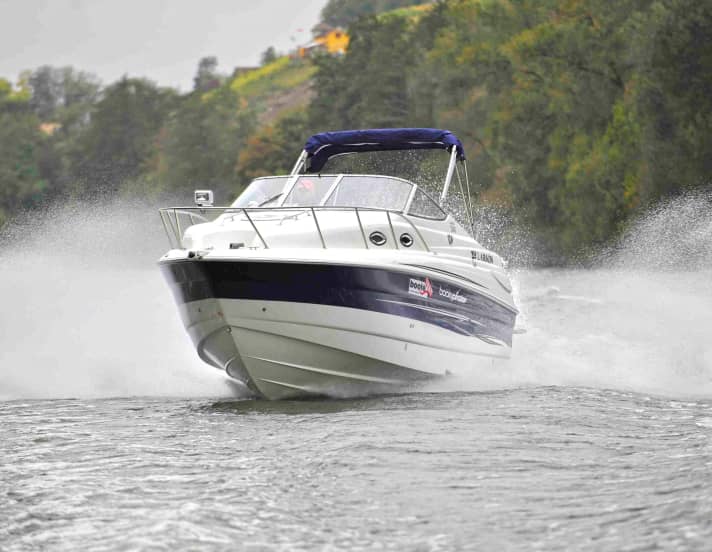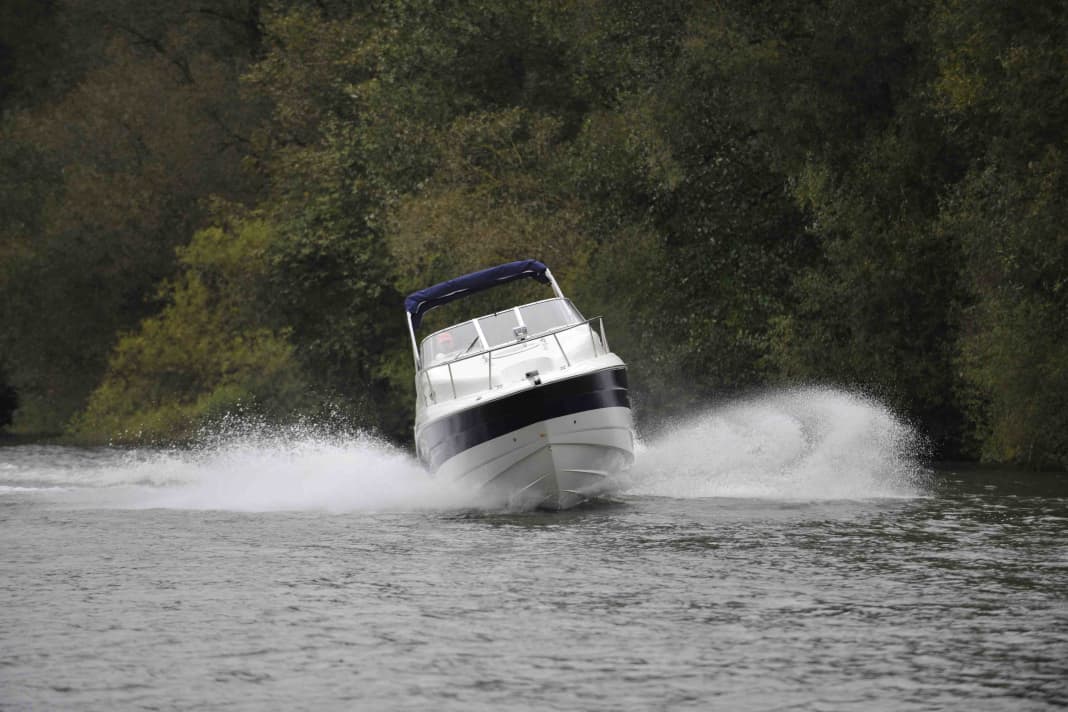







The Larson shipyard is one of the traditional boat builders in the USA with almost a hundred years of experience. It builds bass boats - popular fishing boats in America - outboard motor boats from 5 metres in length, bowriders and day cruisers with inboard motors up to almost 10-metre-long cabin cruisers, including our test boat, the Larson Cabrio 240. As far as the quality of the latter is concerned, we note the following in our test report: overall very solid, clean and neatly finished. High-gloss gelcoat on the outside, the laminate is carefully coated with protective paint on the inside. There are hardly any untreated plastic cut edges. The upholstery is all good, and the technical and electrical installations are neat and tidy except for the wiring under the front headlight.
Larson offers the Cabrio 240 with a petrol or diesel engine with sterndrive. Engines and drives come either from MerCruiser in the USA or from Volvo Penta in Sweden. An unladen weight of 2.6 tonnes promises mobility on the road, provided you have a towing vehicle with a towing capacity of 3.5 tonnes.
Driving and manoeuvring
At idle throttle and with a gear engaged, the two counter-rotating stainless steel propellers on the Bravo-Three-Z drive rotate around their own axis almost three hundred times per minute. This is enough to manoeuvre the test boat well in the harbour. With the rudder hard to port or starboard, a full circle measures around two boat lengths.
When reversing with the gear engaged backwards, a moderate crosswind on the test day prevents the boat from turning from one side to the other. This is where you wish you had a bow thruster. To avoid unnecessary waves during the canal trip, we do not allow the engine to turn more than 1200 rpm and travel at a speed of 6 knots. The Cabrio 240 follows the course it has set; if people change their position in the boat, this only has a minor effect on the course and heel.
Without much effort, our V8 test engine gets the boat planing from 2500 rpm in good visibility and accelerates it up to a maximum speed of 37 knots. The engine turns at its upper limit of 5000 rpm. In view of the low load, this is evidence of a suitable choice of propeller.
After analysing our measurement data, a theoretical range of just under 200 nm plus 15% reserve is calculated at slow speed. Economically, the test boat is travelling at a speed of 23 kn (3500 rpm) at fast planing speed. One tank of petrol is then sufficient for about 186 nm and at full throttle theoretically for a non-stop distance of 135 nm, plus reserves. This means that the Larson Cabrio 240 fulfils our minimum requirement of 150 nm plus reserve if driven economically. That's good.
We rate the sound pressure measurement values as "sufficient", where the comfort limit of 85 dB/A is exceeded from 4000 rpm. The test boat cuts a fine figure in extreme manoeuvres. In the increasingly tight bends, it leans towards the centre of the bend and slows down to a lower planing speed on its own, only to suddenly pick up speed again after steering out. The same manoeuvres with the Z-drive trimmed are accompanied by a slight rocking without hooking in at the tightest points.
The test boat leans normally towards the centre of the turn and the resulting centrifugal forces are very stable at 0.8 g. When the rudder is turned, the boat follows the course without any negative reactions, and on the imaginary slalom course it swings safely over its longitudinal axis. The Main near Schweinfurt does not have any rough water or waves. This is where excursion boats and commercial shipping come in, whose waves are easily managed.
The co-drivers can sit on a bench seat on the port side and in front of the rear bulwark. The driver sits at his clearly organised workplace in an adjustable bucket seat that provides lateral support for his shoulders. The seat cushion can be folded up at the front for travelling in a standing position. In order to be able to operate the gearstick comfortably, the driver would like it to be mounted about 10 cm further aft. The compass is not installed directly in front of the driver, but like the log, plumb line and windscreen wipers, it is part of the standard equipment.
Engine, tank, electrics
The V8 MerCruiser is tucked under a large cockpit floor hatch and stands almost free in a very clean and clearly organised engine compartment. It also houses the water and waste tank, charger, boiler and two well-mounted batteries. The shipyard hides the main switch under a cockpit side cushion on the port side, complete with automatic fuses.
The Larson designers have accommodated additional plug-in fuses opposite in the storage cupboard of the cockpit sink. The switch panel for the 230 V shore power connection, an extra, is located in the galley block. Part of the plastic fuel tank is visible in the engine compartment, including the connections. The engine manufacturer is solely responsible for cleaning the fuel tank, as the shipyard has dispensed with a fuel tap. However, the non-return valve in the fuel line on the tank is no substitute.
Security
Like the anchor locker, the cockpit is bilged outboard and all accessible surfaces have an integrated anti-slip structure. The cockpit interior height fits - except for the stern entrance, which is too low. The railing fulfils the height requirement. However, as far as safety of movement is concerned, this is only guaranteed on the foredeck at the bow tip. The bathing ladder is easy to handle from the water, but there is no handle in the ladder area. The boat is only steered using electric bilge pumps; the Americans have not provided a hand bilge pump. Better: An automatic fire extinguishing system in the engine compartment should prevent the worst in an emergency.
Living, cockpit and equipment
The companionway at the driving position leads into the living area. The foredeck is dominated by a U-shaped seating area with removable table. The bench seat can be converted into a double berth using insertable rods and cushions. Light and air enter through portholes and a ceiling escape hatch.
The galley block on the port side includes a sink, ceramic hob and refrigerator. In addition to the microwave, the highlight is a standard coffee machine permanently installed above the hob. The bathroom is small and cosy, at least in terms of headroom and washbasin. An electric toilet and sink are standard, as is hot and cold running water for the bathroom and pantry.
The bathroom is ventilated via a porthole. Under the cockpit floor, the designer has integrated a double berth that extends across the entire width of the boat, which must be entered in a stooped position. However, the overall feeling of space is acceptable. Storage space is provided by the bench seat at the front, a small wardrobe by the bathroom and the galley.
There is an ice box in the cockpit for stowing drinks. You can lie down on the double bench seat on the port side, which is pulled apart, plus the fold-out rear bench seat. The storage space in the cockpit is manageable and fender holders are rare. The folded canopy frame with standard bimini is enthroned above the cockpit. Side, rear and front parts cost extra.
The same applies to the navigation lights authorised in Germany. There are six mooring cleats, towing eyes fore and aft, a waterskiing hook above the platform and the bow fitting including the empty
Data sheet: Larson 240
Shipyard: Larson Boats
Type designation: Larson 240
CE category: C - Coastal waters
Material of hull and deck: Plastic
Length: 7,53 m
Width: 2,59 m
Displacement: 2,61 t
Price: 90.510,00 €

